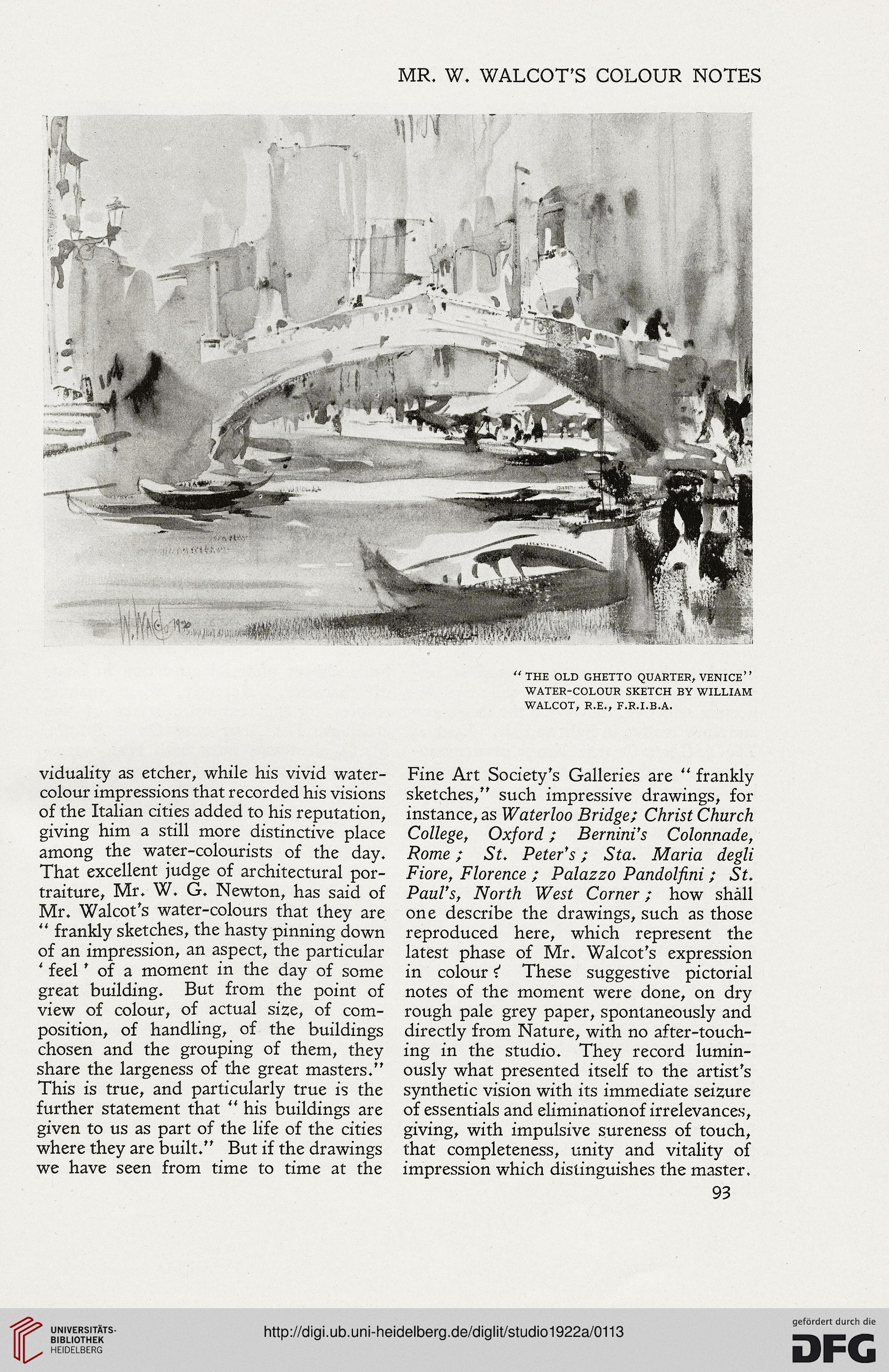MR. W. WALCOT'S COLOUR NOTES
"THE OLD GHETTO QUARTER, VENICE"
WATER-COLOUR SKETCH BY WILLIAM
WALCOT, R.E., F.R.I.B.A.
viduality as etcher, while his vivid water-
colour impressions that recorded his visions
of the Italian cities added to his reputation,
giving him a still more distinctive place
among the water-colourists of the day.
That excellent judge of architectural por-
traiture, Mr. W. G. Newton, has said of
Mr. Walcot's water-colours that they are
" frankly sketches, the hasty pinning down
of an impression, an aspect, the particular
' feel' of a moment in the day of some
great building. But from the point of
view of colour, of actual size, of com-
position, of handling, of the buildings
chosen and the grouping of them, they
share the largeness of the great masters."
This is true, and particularly true is the
further statement that " his buildings are
given to us as part of the life of the cities
where they are built." But if the drawings
we have seen from time to time at the
Fine Art Society's Galleries are " frankly
sketches," such impressive drawings, for
instance, as Waterloo Bridge; Christ Church
College, Oxford; Bernini's Colonnade,
Rome; St. Peter's; Sta. Maria degli
Fiore, Florence ; Palazzo Pandolfini ; St.
Paul's, North West Corner; how shall
one describe the drawings, such as those
reproduced here, which represent the
latest phase of Mr. Walcot's expression
in colour i These suggestive pictorial
notes of the moment were done, on dry
rough pale grey paper, spontaneously and
directly from Nature, with no after-touch-
ing in the studio. They record lumin-
ously what presented itself to the artist's
synthetic vision with its immediate seizure
of essentials and eliminationof irrelevances,
giving, with impulsive sureness of touch,
that completeness, unity and vitality of
impression which distinguishes the master.
93
"THE OLD GHETTO QUARTER, VENICE"
WATER-COLOUR SKETCH BY WILLIAM
WALCOT, R.E., F.R.I.B.A.
viduality as etcher, while his vivid water-
colour impressions that recorded his visions
of the Italian cities added to his reputation,
giving him a still more distinctive place
among the water-colourists of the day.
That excellent judge of architectural por-
traiture, Mr. W. G. Newton, has said of
Mr. Walcot's water-colours that they are
" frankly sketches, the hasty pinning down
of an impression, an aspect, the particular
' feel' of a moment in the day of some
great building. But from the point of
view of colour, of actual size, of com-
position, of handling, of the buildings
chosen and the grouping of them, they
share the largeness of the great masters."
This is true, and particularly true is the
further statement that " his buildings are
given to us as part of the life of the cities
where they are built." But if the drawings
we have seen from time to time at the
Fine Art Society's Galleries are " frankly
sketches," such impressive drawings, for
instance, as Waterloo Bridge; Christ Church
College, Oxford; Bernini's Colonnade,
Rome; St. Peter's; Sta. Maria degli
Fiore, Florence ; Palazzo Pandolfini ; St.
Paul's, North West Corner; how shall
one describe the drawings, such as those
reproduced here, which represent the
latest phase of Mr. Walcot's expression
in colour i These suggestive pictorial
notes of the moment were done, on dry
rough pale grey paper, spontaneously and
directly from Nature, with no after-touch-
ing in the studio. They record lumin-
ously what presented itself to the artist's
synthetic vision with its immediate seizure
of essentials and eliminationof irrelevances,
giving, with impulsive sureness of touch,
that completeness, unity and vitality of
impression which distinguishes the master.
93




